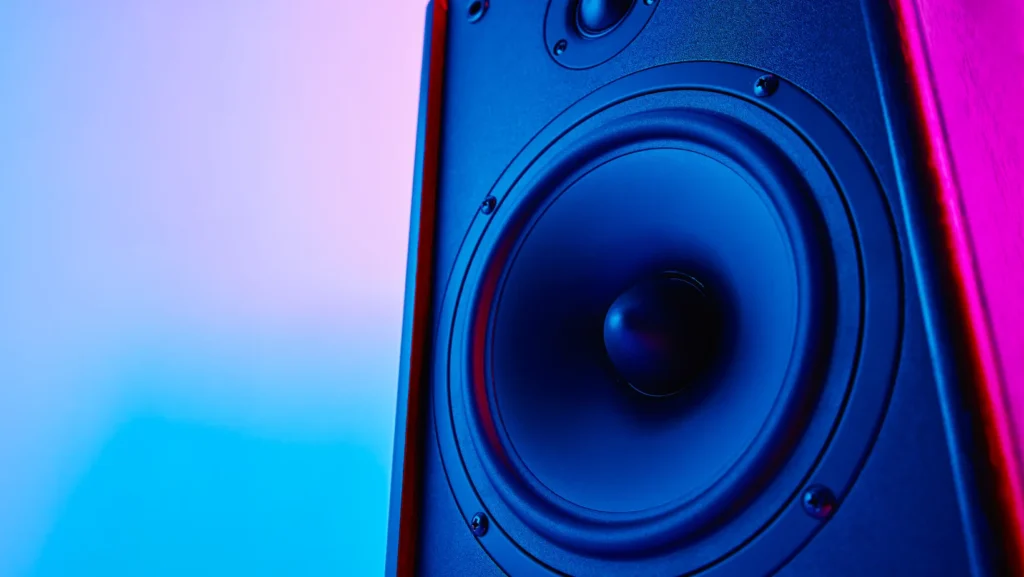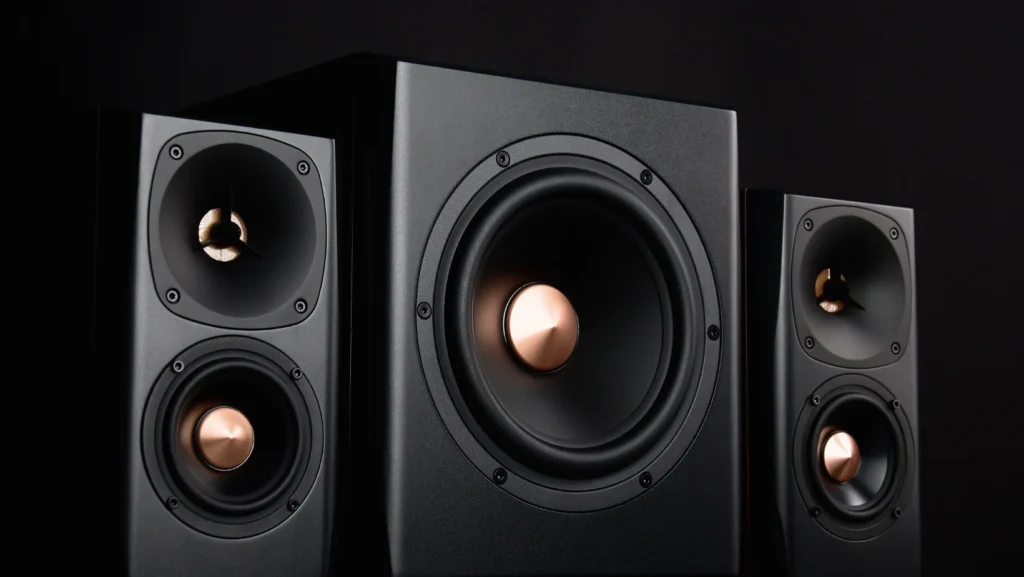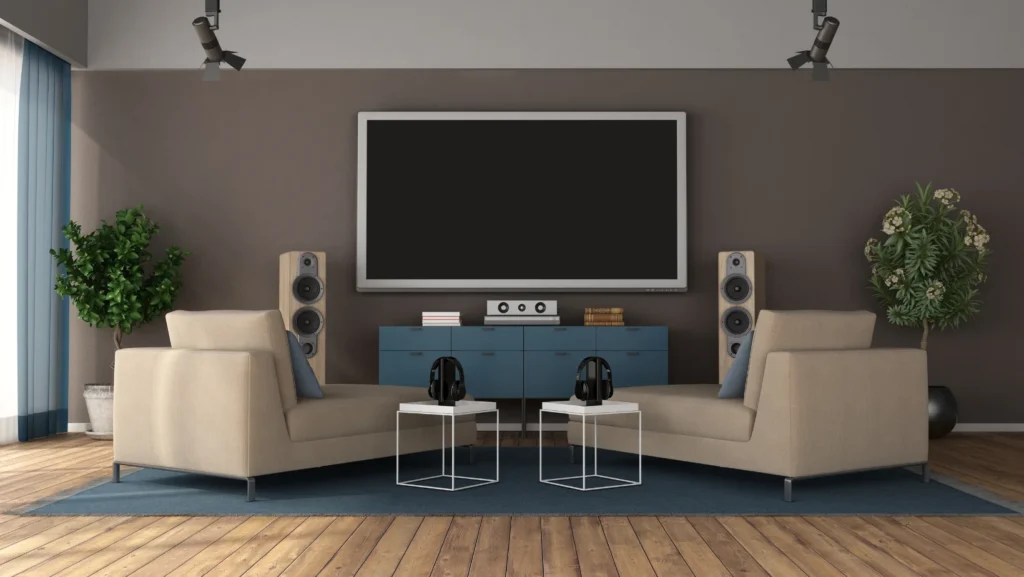Subwoofers are an essential component of any audio system, known for their ability to reproduce low-frequency sounds with depth and power. From enhancing the rumble of explosions in action movies to delivering the thunderous beats of bass-heavy music genres, subwoofers play a crucial role in creating a rich and immersive audio experience.
In this article, we’ll explore what subwoofers are, how they work, and why they are indispensable for audio systems of all kinds. Whether you’re a music enthusiast, a movie buff, or an audiophile seeking to elevate your sound setup, understanding the significance of subwoofers is key to unlocking the full potential of your audio system.
Are you ready to take your audio experience to the next level?
Discover the secret behind the thunderous lows and spine-tingling bass that bring your favorite music, movies, and games to life. Unlock the secrets behind their ability to add depth and impact to your music.
Dive deep into the world of subwoofers and uncover why they are essential for achieving immersive soundscapes and heart-pounding audio moments. Experience immersive sound like never before and elevate every listening session with the powerful presence of a quality subwoofer.
Keep reading as we explore the anatomy of subwoofers, their role in audio systems, and how they elevate your listening experience to new heights!
Did you know?
- The name of the woofer is from the onomatopoeic English word for a dog’s deep bark, “woof“.
- According to The Insight Partners, the subwoofer market is expected to grow from $834.77 million in 2021 to $1,132.62 million by 2028.
Introduction to Subwoofers

Subwoofers are specialized loudspeakers designed to reproduce low-frequency audio signals, particularly bass frequencies.
Unlike traditional speakers that handle a wide range of frequencies, subwoofers are dedicated to delivering deep, powerful bass sounds. They are an essential component of audio systems, enhancing the overall sound quality and providing a more immersive listening experience.
How Subwoofers Work?
Subwoofers work by reproducing low-frequency audio signals, typically in the range of 20 to 200 Hz, which are below the capabilities of standard speakers. They feature large drivers, usually 8 inches or more in diameter, and are housed in a specially designed-enclosure to maximize bass response. When an audio signal is sent to the subwoofer, the driver moves back and forth, creating sound waves that you can feel as deep, rumbling bass.
Here’s a detailed explanation:
- Low-Frequency Reproduction: Subwoofers are designed to reproduce low-frequency audio signals, typically ranging from 20 to 200 Hz, which are below the capabilities of standard speakers.
- Large Drivers: They feature large drivers, usually 8 inches or more in diameter, capable of moving significant amounts of air to produce deep bass.
- Specialized Enclosures: Subwoofers are housed in specially designed enclosures that are optimized for bass response, helping to enhance and amplify the low-frequency sound output.
- Deep, Rumbling Bass: When an audio signal is sent to the subwoofer, the driver moves back and forth, creating sound waves that you can feel as deep, rumbling bass, adding depth and realism to your audio experience.
The Role of Subwoofers in Audio Systems

Subwoofers play a crucial role in audio systems by handling low-frequency sounds, typically those below 200Hz, that other speakers struggle to reproduce effectively.
Here’s how they contribute to enhancing the overall audio experience:
Deep Bass Reproduction:
Subwoofers are designed to reproduce low-frequency sounds accurately and powerfully, including deep bass tones that add depth and richness to music, movies, and other audio content.
Balanced Frequency Response:
By handling low-frequency reproduction, subwoofers complement the main speakers, which are often unable to reproduce deep bass frequencies with the same clarity and impact. This balanced frequency response ensures that all aspects of the audio spectrum are represented faithfully.
Immersive Listening Experience:
Subwoofers create a more immersive listening experience by filling in the sonic gaps left by the main speakers. They add weight and realism to sound effects in movies, making explosions, rumbling engines, and other low-frequency sounds more lifelike and impactful.
Reduced Strain on Main Speakers:
By offloading the task of reproducing deep bass frequencies, subwoofers reduce the strain on main speakers, allowing them to focus on midrange and high-frequency sounds. This results in clearer, more detailed audio reproduction across the entire frequency range.
Subwoofers play a vital role in enhancing the depth, realism, and overall quality of sound in audio systems, making them essential components for anyone seeking a truly immersive listening experience.
Benefits of Incorporating Subwoofers
Incorporating subwoofers into audio systems offers several benefits that enhance the overall listening experience:
Enhanced Low-Frequency Response:
Subwoofers reproduce low-frequency sounds with greater clarity and impact than main speakers alone, providing a richer and more immersive listening experience, especially in genres like electronic music, hip-hop, and action movies.
Balanced Audio Reproduction:
Subwoofers complement the performance of main speakers by handling the low end of the audio spectrum, ensuring a balanced frequency response across all audible frequencies. This results in more accurate sound reproduction and improved tonal balance.
Improved Soundstage and Imaging:
Subwoofers help create a more expansive soundstage and precise imaging by filling in the lower octaves of sound. This contributes to a more lifelike and immersive audio experience, allowing listeners to pinpoint the location of instruments and voices more accurately.
Reduced Distortion and Strain:
By relieving main speakers of the burden of reproducing deep bass frequencies, subwoofers reduce distortion and strain on the drivers, allowing them to operate more efficiently and deliver cleaner, more articulate sound at higher volumes.
Versatility and Flexibility:
Subwoofers come in various sizes and configurations, allowing users to tailor their audio systems to their specific needs and preferences. Whether it’s a compact subwoofer for a small room or a powerful, high-output subwoofer for a home theater, there are options available to suit every application.
Incorporating subwoofers into audio systems adds depth, impact, and realism to the sound, resulting in a more enjoyable and immersive listening experience for music, movies, and gaming.
Types of Subwoofers
When considering subwoofers for your audio system, it’s essential to understand the different types available.
Here are some common types of subwoofers:
1. Powered Subwoofers:
These subwoofers have built-in amplifiers, making them a self-contained solution for adding bass to your audio system. Powered subwoofers are popular for their ease of setup and versatility.
2. Passive Subwoofers:
Unlike powered subwoofers, passive subwoofers require an external amplifier to drive them. They are often used in larger audio systems or custom installations where more control over amplifier selection is desired.
3. Down-firing Subwoofers:
These subwoofers have their drivers facing downwards, with the sound waves directed towards the floor. Down-firing subwoofers can help minimize the localization of bass frequencies and provide more even bass distribution in the room.
4. Front-firing Subwoofers:
In contrast to down-firing subwoofers, front-firing subwoofers have their drivers facing forward, directly towards the listener. Front-firing subwoofers are commonly used in home theater setups and offer precise bass delivery.
5. Sealed Subwoofers:
Sealed subwoofers feature an enclosure with no ports or vents. They typically deliver tight, accurate bass response with excellent transient response, making them well-suited for music playback where precision is crucial.
6. Ported (or Vented) Subwoofers:
Ported subwoofers have a vent or port in their enclosure, allowing air to escape. This design enhances bass output and efficiency, making ported subwoofers ideal for home theater systems and applications requiring deeper bass extension.
7. Bandpass Subwoofers:
Bandpass subwoofers utilize a combination of sealed and ported enclosures to achieve maximum bass output within a specific frequency range. They are often used in car audio systems and applications where space is limited.
Understanding the different types of subwoofers can help you choose the right one for your audio system based on your specific needs, preferences, and room acoustics.
Considerations When Choosing a Subwoofer

When selecting a subwoofer for your audio system, several key considerations can help you make the best choice.
Here are some factors to keep in mind:
Room Size and Acoustics: Consider the size and layout of your room, as well as its acoustic properties. Larger rooms may require a more powerful subwoofer to fill the space with bass effectively. Additionally, the room’s acoustics, such as wall and floor materials, can affect bass response and sound quality.
Frequency Response:
Pay attention to the subwoofer’s frequency response range, which indicates the lowest and highest frequencies it can reproduce. Choose a subwoofer with a frequency response that complements your main speakers and extends low enough to reproduce deep bass frequencies accurately.
Power and Amplification:
Look for a subwoofer with sufficient power output to match the size of your room and desired listening levels. Consider whether you prefer a powered subwoofer with a built-in amplifier for convenience or a passive subwoofer that requires an external amplifier for more flexibility.
Placement Options:
Determine where you plan to place the subwoofer within your room. Subwoofer placement can significantly impact bass performance and overall sound quality. Experiment with different placement options, such as corner placement or near-field placement, to find the optimal position for your subwoofer.
Integration with Existing System:
Ensure compatibility between the subwoofer and your existing audio system, including the main speakers and amplifier or receiver. Look for features such as crossover controls, phase adjustment, and connection options (e.g., RCA, speaker-level inputs) that facilitate seamless integration and optimal bass management.
Room Correction and EQ:
Some subwoofers offer built-in room correction technologies or EQ controls to compensate for room acoustics and optimize bass response. Consider whether these features are essential for achieving the best sound quality in your listening environment.
Budget:
Determine your budget for a subwoofer and explore options within your price range. While higher-priced subwoofers may offer advanced features and superior performance, there are also quality options available at more affordable price points.
By considering these factors when choosing a subwoofer, you can select the right model that enhances your audio system’s bass performance and delivers an immersive listening experience tailored to your preferences and room characteristics.
Integrating Subwoofers into Your Audio Setup
Integrating subwoofers into your audio setup can significantly enhance the overall sound quality and listening experience. Here’s how to effectively integrate subwoofers into your system:
Placement:
Experiment with subwoofer placement to find the optimal position within your room. While corner placement often provides the most bass reinforcement, it may not always result in the most accurate bass response. Try placing the subwoofer along the front wall, near-field placement between the main speakers, or using multiple subwoofers for smoother bass distribution.
Crossover Settings:
Configure the crossover settings on your subwoofer and AV receiver or amplifier to ensure seamless integration with your main speakers. The crossover frequency determines the point at which bass frequencies are redirected from the main speakers to the subwoofer. Set the crossover frequency based on the capabilities of your main speakers and the low-frequency extension of your subwoofer.
Phase Alignment:
Adjust the phase control on the subwoofer to achieve optimal phase alignment with the main speakers. Phase alignment ensures that the bass frequencies from the subwoofer reinforce rather than cancel out the bass from the main speakers. Experiment with phase settings to achieve the smoothest bass response and cohesive soundstage.
Room Correction:
Take advantage of room correction technologies, such as Audyssey or Dirac Live, if available in your AV receiver or processor. Room correction systems analyze room acoustics and automatically adjust the subwoofer’s output to compensate for room resonances and optimize bass response. Run the room correction calibration process to achieve more accurate and consistent bass performance across different listening positions.
Volume Level Matching:
Calibrate the volume level of the subwoofer to ensure balanced bass integration with the main speakers. Use a sound pressure level (SPL) meter or the built-in calibration tools in your AV receiver to set the subwoofer’s volume level to match that of the main speakers. Aim for a smooth transition between the main speakers and the subwoofer, avoiding excessive bass dominance or localization.
Fine-Tuning:
Fine-tune the subwoofer settings, such as low-pass filter, phase, and EQ adjustments, based on your listening preferences and room characteristics. Some subwoofers offer advanced features like parametric EQ or room gain compensation to further optimize bass performance. Take the time to experiment with different settings and listening positions to achieve the best possible bass response.
By following these steps, you can seamlessly integrate subwoofers into your audio setup, enhance bass performance, and enjoy a more immersive and engaging listening experience across music, movies, and games.
Subwoofer Placement and Setup Tips

Proper subwoofer placement and setup are crucial for achieving optimal bass performance in your audio system.
Here are some tips to help you get the most out of your subwoofer:
Corner Placement:
Placing the subwoofer in a corner of the room can often result in the most bass reinforcement, as corners tend to amplify low-frequency sound waves. However, corner placement may not always yield the most accurate bass response and can lead to boomy or uneven bass. Experiment with different corner locations to find the optimal balance between bass impact and clarity.
Near-Field Placement:
For more precise bass reproduction and better integration with the main speakers, consider placing the subwoofer near-field, between the main speakers, or slightly off-center. Near-field placement minimizes room interactions and can help reduce bass localization, resulting in a tighter and more controlled bass response.
Boundary Reinforcement:
Positioning the subwoofer near a wall or boundary can further reinforce bass output, enhancing overall bass impact and extension. However, be mindful of potential boundary reinforcement effects, which can lead to excessive bass buildup and uneven frequency response. Experiment with subwoofer placement relative to room boundaries to achieve the desired bass balance.
Symmetrical Placement:
If using dual subwoofers, aim for symmetrical placement to achieve more uniform bass distribution throughout the listening area. Position the subwoofers equidistant from the main listening position and maintain consistent placement relative to room boundaries. Dual subwoofers can help minimize room modes and improve bass consistency across different listening positions.
Phase Alignment:
Ensure proper phase alignment between the subwoofer and main speakers to prevent phase cancellation and achieve coherent bass reproduction. Most subwoofers feature a phase control knob that allows you to adjust the phase relationship between the subwoofer and main speakers. Experiment with phase settings to find the optimal alignment that results in smoother bass integration.
Room Acoustics:
Consider room acoustics and furnishings when positioning the subwoofer. Heavy furniture, thick carpets, and curtains can absorb bass frequencies, affecting bass response and room resonance. Experiment with room treatments and acoustic panels to minimize reflections and improve bass clarity.
Calibration:
Use room correction software or built-in calibration tools in your AV receiver or subwoofer to optimize bass performance. Room correction systems analyze room acoustics and automatically adjust subwoofer settings, such as crossover frequency, phase, and EQ, to compensate for room resonances and achieve more accurate bass reproduction.
By following these placement and setup tips, you can maximize the performance of your subwoofer and enjoy a more immersive and balanced listening experience with deep, powerful bass.
Common Myths About Subwoofers
Myth: Subwoofers are only for playing loud, booming bass.
Reality: While subwoofers excel at reproducing deep bass frequencies, they also contribute to overall sound quality by enhancing the full range of audio content, including music, movies, and games. A well-integrated subwoofer can provide more balanced and immersive audio playback, not just thunderous bass.
Myth: Subwoofers are only necessary for home theater systems.
Reality: While subwoofers are commonly associated with home theater setups for their ability to reproduce cinematic low-frequency effects, they can benefit any audio system. Whether you’re listening to music, watching TV shows, or gaming, a subwoofer can enhance the realism and impact of sound across various media formats.
Myth: Adding a subwoofer to your audio system will create excessive bass that disturbs neighbors.
Reality: Subwoofers can be adjusted and calibrated to suit your listening preferences and room environment. With proper setup and configuration, you can enjoy rich and powerful bass without causing disturbance to neighbors. Additionally, many subwoofers offer features like volume control and room correction to optimize bass performance while minimizing unwanted noise.
Frequently Asked Questions About Subwoofers: What Are They and Why Are They Essential for Audio Systems?
Q: What is a subwoofer and why is it important in an audio system?
A: A subwoofer is a specialized speaker designed to reproduce low-frequency sounds, typically below 120 Hz. It is essential for audio systems because it enhances the bass response, providing deep and impactful low-end frequencies that add realism and depth to music, movies, and other audio content.
Q: How does a subwoofer differ from other speakers in an audio system?
A: Unlike other speakers, such as tweeters and midrange drivers, which focus on reproducing higher-frequency sounds, subwoofers are dedicated to handling low-frequency bass. They are specifically designed to produce deep, powerful bass notes with greater efficiency and accuracy, enriching the overall audio experience.
Q: What are the benefits of adding a subwoofer to my audio setup?
A: Incorporating a subwoofer into your audio system offers several benefits, including:
- Enhanced Bass Response: Subwoofers reproduce low-frequency sounds with greater impact and depth, filling out the lower end of the audio spectrum.
- Improved Sound Quality: By offloading bass duties from the main speakers, subwoofers reduce distortion and strain on the speakers, resulting in cleaner and more articulate sound reproduction.
- Immersive Listening Experience: Subwoofers create a more immersive and lifelike audio environment, allowing you to feel the impact of explosions in movies or the thumping bassline in music.
- Room Acoustic Correction: Subwoofers can help compensate for room acoustics and placement challenges, mitigating bass anomalies and providing more consistent bass performance throughout the listening area.
Q: How do I integrate a subwoofer into my existing audio system?
A: Integrating a subwoofer into your audio setup involves connecting it to your AV receiver or amplifier using a subwoofer cable and configuring the crossover settings to ensure seamless integration with your main speakers. Additionally, you may need to experiment with subwoofer placement and room calibration techniques to optimize bass performance and achieve balanced sound reproduction.
Final Thoughts
In summary, subwoofers are essential for audio systems because they deliver deep, powerful bass that enhances music, movies, and gaming experiences. By filling out the lower frequencies, subwoofers add richness and realism to sound reproduction, making for a more immersive listening or viewing experience. Whether you’re a music lover or a movie buff, having a subwoofer can greatly enhance the enjoyment of your audio setup.

